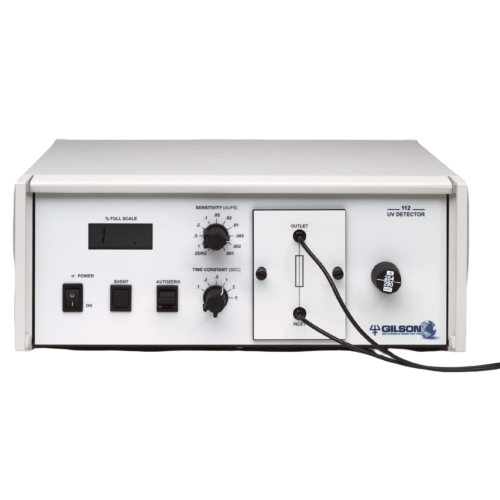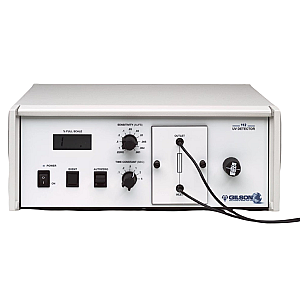The Gilson 112 UV detector is a robust and economical instrument designed to monitor column effluent at a fixed wavelength in liquid chromatography (LC/HPLC). With simple front-panel controls, it allows you to adjust sensitivity, response time, send event marks and reset the signal. Compatible with Gilson modular systems and other commercial systems, it offers great flexibility with a choice of flow cells suitable for analytical, preparative and microbore applications.
UV Detector 112 - Good Condition


Offer Details
Accessories :
40419
Options :
Delivery time between 10-14 working days
Description
Gilson 112 UV detector – Reliable performance for liquid chromatography
The Gilson 112 UV detector is designed for continuous monitoring of column effluent at a single wavelength, either 254 nm or 280 nm, selectable by simply pressing or pulling a button on the front panel. It uses a low-pressure mercury lamp, with or without a phosphorescent coating, depending on the desired wavelength. This detector is equipped with a silicon UV photodiode, ensuring accurate and stable detection.
The dual-beam optical system with interference filter ensures reliable measurement, even in demanding laboratory environments. The Gilson 112 is UL and CE certified, meeting safety and electromagnetic compatibility standards.
Flexibility of installation and use
The Gilson 112 can be easily integrated into any LC or HPLC system, whether from Gilson or another manufacturer. It offers three analogue output channels: two with variable sensitivity (10 mV and 100 mV full scale) and one with fixed sensitivity (10 mV to 1 AUFS). These outputs allow direct connection to a recorder or data analysis device.
The electrical configuration is adaptable thanks to a voltage selector (100–120 V or 220–240 V) and appropriate fuses. The rear panel provides clear connections for power, recorder outputs, and remote event/auto-zero functions.
Suitable for a variety of chromatographic applications
The Gilson 112 is compatible with several quartz flow cells, each suited to specific volumes and path lengths. This allows use in applications ranging from microbore to high-throughput preparation. The cells are designed to withstand pressures up to 1000 psi (70 kg/cm²).
Sensitivity is adjustable from 0.001 to 1 AUFS with a standard 10 mm cell, and can reach up to 100 AUFS with shorter path length cells. The response time is selectable between 0.1 and 5 seconds, allowing for optimised peak resolution and background noise reduction.
The detector is also equipped with a digital LCD display showing the percentage of full scale, facilitating the calculation of absorbance based on sensitivity and path length.
Features
- Fixed wavelength UV monitoring (254/280 nm)
- Simple front panel controls: sensitivity, auto-zero, event
- Three analogue output channels (10 mV, 100 mV, fixed)
- Compatible with recorders and data analysis systems
- Interchangeable flow cells for various applications
- Digital display for direct reading of absorbance
- Manual or remote auto-zero function
- Manual or remote event marking
- Easy installation with voltage selector and integrated fuse
Technical Details
- Detector type: Silicon UV photodiode
- Wavelengths: 254 nm / 280 nm
- Auto-zero range: -0.5 to +1 AU, accuracy of 5 x 10⁻⁵ AU
- Sensitivity: 0.001 to 1 AUFS (standard), up to 100 AUFS depending on the cell
- Response time: 0.1, 0.2, 0.5, 1, 2 or 5 seconds
- Display: 3½-digit LCD, % of full scale
- Dimensions: 32 × 32 × 13 cm (12.6 × 12.6 × 5.2 in)
- Weight: 8 kg net
- Temperature range: 5–40 °C
- Power supply: 100–120 V or 220–240 V, 50/60 Hz
- Current: 1.0 A (100–120 V) or 0.5 A (220–240 V)
- Optics: Dual beam with interference filter
- Reference chamber: Air
- Minimum detection: <8 × 10⁻⁵ AU
- Noise at 254 nm: 4.0 × 10⁻⁵ AU (short term), 6.0 × 10⁻⁵ AU (long term)
- Noise at 280 nm: 6.0 × 10⁻⁵ AU (short and long term)
- Thermal drift: 3.0 × 10⁻⁴ AU/°C
- Voltage deviation: <2 × 10⁻⁵ AU for 1% line variation
Compatible Accessories
- Event/auto-zero cable
- Pomona recorder cable
- Additional flow cells (analytical, LC, preparative, microbore)
- Pressure regulator